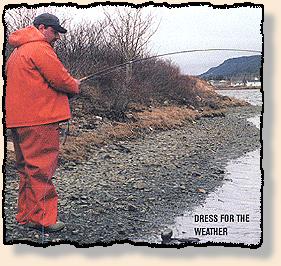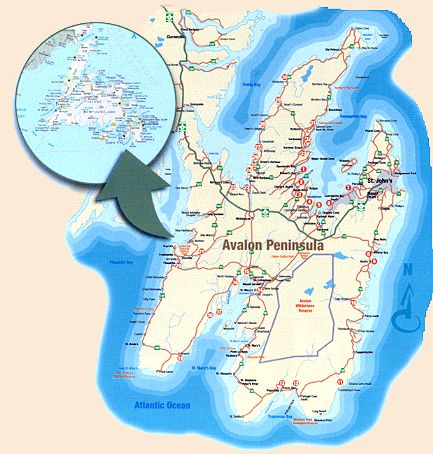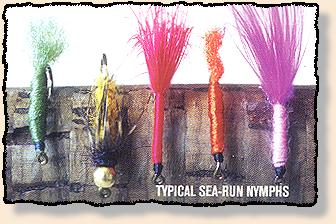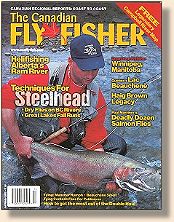Sea-Run Brown Trout Fishing in Newfoundland
Part 2
By Paul Smith
Where To Fish
Shearstown Pond:
Provides excellent fishing all season from February though October. Winter
fishing is especially good farther up the pond away from the saltwater.
Spring and summer fishing is best right out where the fresh water meets
to salt.
South River:
Has a reputation for big trout. In the spring of 1998 a 19-pounder was taken
here, and trout over 10 pounds are relatively common. South River is also
a scheduled Atlantic salmon river.
Avondale River:
This is a small but productive fishery on the south side of Conception Bay.
It accounts for its share of trout all through the season.
New Harbour River
This is a good early season river on the south side of Trinity Bay.
Quidi Vidi River:
This river flows out of Quidi Vidi Lake. Located right in the capital city
this river produces some fine sea trout.
Witless Bay River
Here's where the big ones swim. The Newfoundland record 28-pound fish
was taken here. Other world class fish, including a 24-pound specimen was
landed this spring by local, John Tobin and a 20.5-pounder taken by his brother,
Pat, in 1986.
Salmonier River
This is a beautiful scheduled salmon river that also houses some big browns.
It's best fished in late summer and fall and is noted for excellent dry fly
fishing.
Winter and Early Spring Fishing
 For the more hardy of us, sea trout fishing begins in mid-winder (early February).
Survial suits and lined boots are typical attire. Be prepared to deal with ice
build-up on your rod guides.
For the more hardy of us, sea trout fishing begins in mid-winder (early February).
Survial suits and lined boots are typical attire. Be prepared to deal with ice
build-up on your rod guides.
Fishing this time of year is best around tidal estuaries. The tide has a big
influence on fishing success, but there is no general rule on whether rising or
falling tide is best. It varies from river to river.
Ice cover can make fishing im-possible at the beginning of February. Only limited places
are worth trying at this time. Watch for crowds. The locals know where the fish are.
The best flies in early season are small (#12 to #16) Black Silver Tips and Brown Hackles.
Both are very simple, easy-to-tie patterns. Weighting them with lead or a bead head is an
option. Other small nymph patterns, such as the Hare's Ear, and bead heads in olive, black
and brown will also work.
Late Spring and Early Summer
As the season progresses into early summer, fishing for sea-run browns more closely
resembles resident trout fishing. They can now be tempted to the surface for dry flies
such as small bugs or ordinary mayfly patterns. The early season wet flies will still work,
but are usually fished closer to the surface.

By this time, the trout will have re-located. In June and early July they tend to hold up
right where the rivers meet the sea (tidal tailwaters). You can get some excellent fishing
if you time the tide just right to hit that short, optimum period of ebbing between low and
rising tide. The tide will push in and out for about an hour before it becomes a fully rising
tide. Change flies often, and try different sizes. The fish can be very fussy. You might think
there isn't a fish in the water, but change from a #14 to a #16 and, bingo, you have a fish on.
Mid-summer Lull
There is usually a mid-summer lull when only a few resident trout are left in the rivers
and estuaries. During this time, the sea-going trout are pursued in the sheltered bays,
usually by trolling with spoons and lures. Not much fly fishing is carried out in salt water
and there is little local expertise, but I feel there is a great opportunity here for trolling with
salt water and streamer patterns. You would need a boat at least 16 feet in length for this,
since even sheltered bays get pretty rough here in Newfoundland. Personally, I hope to
make my own exploratory excursions into the salt this summer.
Late Summer and Early Fall
In late summer, sea trout begin to return to the rivers. Late August and September offer
some excellent dry fly fishing, particularly with bugs and bombers. Conditions remain
good right up to the close of the season in October.
Fall fishing is much like early summer fishing. Dry flies will work sometimes, but at other
times you may need to go under with nymphs or other weighted patterns. Fall fishing is
also less crowded. Many Newfoundlanders turn to hunting in fall and hardly fish at all.
Personally, I try to find time for both.
Regulations
In Newfoundland there are some 45 rivers and estuaries, mostly on the Avalon Peninsula,
that have been designated as sea-run brown trout waters. This designation allows fishing
outside of the regular brook trout season, and also after salmon fishing is closed on some
scheduled salmon rivers. There are also sea-run browns in many undesignated areas, but
you can only fish in the shorter brook trout season. Brown trout season typically extends
from early February to late October. Fishing is allowed with either spinner or fly, night or
day. The exception is on scheduled salmon waters where it is fly fishing only from a half
hour before sunrise to a half hour after sunset.
For more information, contact the Department of Fisheries and Oceans.

Black Silver Tip
This is probably the most common early season fly.
Hook: 1X long nymph hook such as Mustad 3309, sizes #4 - #8.
Tag: Flat silver tinsel.
Body: Black dubbing or wool with optional silver ribbing.
Hackle: A very sparsely wound black hen hackle.
Brown Hackle
Hook: 1X long nymph hook, sizes #4 - #8.
Body: Brown wool or dubbing.
Hackle: A very sparsely wound brown hen hackle.
 I'm not sure what these imitate, but they work. They should be fished wet between 6 inch
and 12 inch beneath the surface, as this early in the season, browns will not often come to
dry flies. In still or slowly moving tidal water, strip the fly very slowly or just let it drift naturally
in the tide. A strike indicator helps when drifting. You can experiment with different shades
and sizes until something works.
I'm not sure what these imitate, but they work. They should be fished wet between 6 inch
and 12 inch beneath the surface, as this early in the season, browns will not often come to
dry flies. In still or slowly moving tidal water, strip the fly very slowly or just let it drift naturally
in the tide. A strike indicator helps when drifting. You can experiment with different shades
and sizes until something works.
Even simple patterns consisting of nothing but dyed seal fur (orange or yellow) dubbed on
a long nymph hook, such as Mustad 3665A, are also effective when fished on a fast strip.
And just a piece of red wool tied on a nymph hook has hooked its share of fish in early
season. ~ Paul Smith
|



